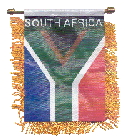Briefly mentioned last newsletter, this year is the 150th
birthday of Oregon, location of the international headquarters
of
 .
Furthermore, we're located in Oregon City, the first US city to
be incorporated west of the Rocky Mountains.
.
Furthermore, we're located in Oregon City, the first US city to
be incorporated west of the Rocky Mountains.
What's all this have to do with flags? Well, by law a new star
is added to the US flag on July 4th following the admission of a
new state into the Union. Oregon was the 33rd State, being
granted Statehood on February 14th, 1859. Hence the 33 star flag
was adopted and flown until 1861.
Another interesting historical note: due to its place in time,
this was also the first flag fired upon by the Confederate army
in the Civil War.
So, Dear Reader, if you live in the United States, do you know
when your star was added?
For more information on historical flags, please
contact us.

"Factoids"
Fimbri-what?
Fimbriation. Originally an heraldic term ... wait. What's that?
Having to do with heraldry ... wait. What's that? Mostly, it's
the design of coats of arms and such. In any event, fimbriation
can basically apply to the separation of colors in a design for
whatever reason - whether in a coat of arms or a flag.
However, it can also refer to the process of decorating with a
fringe.
Perhaps not surprisingly the word comes from the Latin
fimbriatus, from fimbriae, meaning "fringe". But you
knew that.
Anyway, to get on with this story, it occured to us as curious
that our
Mini-Banner of South Africa is an example of a fimbriated
flag design that is displayed with fimbriation.

Happy April.

Other Flag Tidbits
In 1916, US President Woodrow
Wilson officially proclaimed June 14th as US Flag Day in
reference to the adopting of the Stars and Stripes by the
Continental Congress on June 14, 1777. However, it wasn't until
August of 1949 that Congress established National Flag Day.